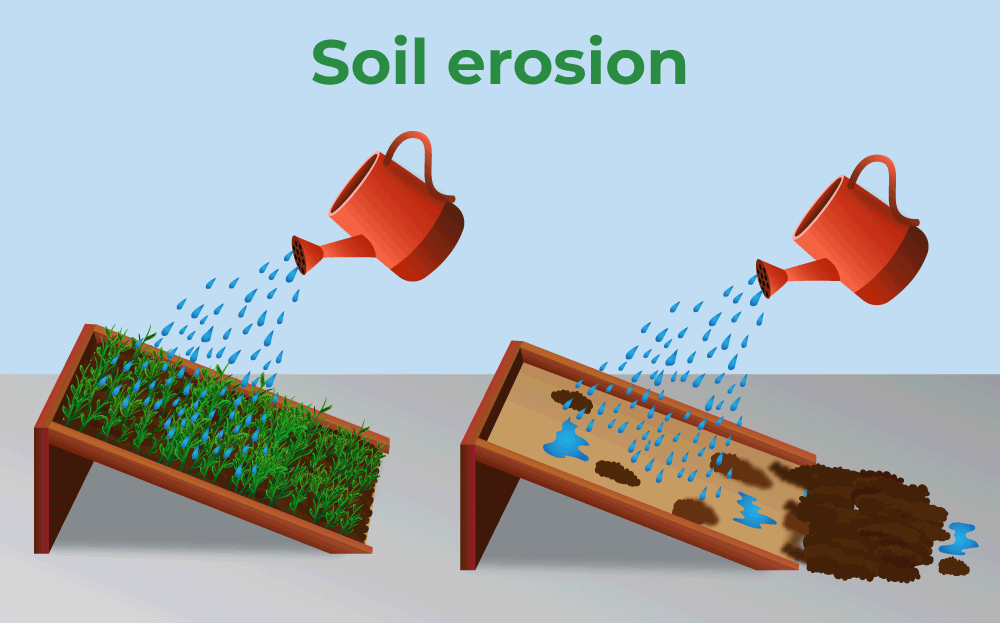Introduction
Soil erosion and land degradation are pressing environmental issues that threaten agricultural productivity, biodiversity, and ecosystem health. Erosion, the process by which soil is worn away by wind, water, or other natural forces, can lead to the loss of fertile topsoil, reduced agricultural output, and the destruction of habitats. Land restoration aims to reverse these effects by rehabilitating degraded landscapes and improving soil health. Non-Governmental Organizations (NGOs) play a crucial role in addressing these challenges through innovative approaches, community engagement, and advocacy. This article explores the impact of soil erosion, the significance of land restoration, and the various strategies NGOs employ to combat these environmental issues.
Keywords: soil erosion, land restoration, NGOs, erosion control, sustainable land management, reforestation, soil conservation, environmental rehabilitation, land degradation, habitat restoration.
Section 1: Understanding Soil Erosion
1.1 What is Soil Erosion?
Soil erosion is the removal of the top layer of soil, which is the most fertile and rich in nutrients. This process can be caused by various factors:
- Water Erosion: Rainfall and surface runoff can wash away soil, leading to rill and gully formation.
- Wind Erosion: In arid and semi-arid regions, strong winds can lift and transport loose, dry soil particles.
- Tillage Erosion: Agricultural practices such as plowing and tilling can disrupt soil structure and increase erosion risk.
- Human Activities: Deforestation, construction, and improper land use can exacerbate soil erosion by removing vegetation and altering natural landscapes.
1.2 Causes and Consequences of Soil Erosion
The causes of soil erosion are multifaceted:
- Deforestation: Removal of trees and vegetation reduces soil stability and increases susceptibility to erosion.
- Agricultural Practices: Intensive farming, overgrazing, and monoculture can degrade soil structure and increase erosion.
- Construction and Urbanization: Development projects often disturb soil and reduce natural vegetation, leading to increased erosion.
- Climate Change: Extreme weather events, such as heavy rainfall and droughts, can exacerbate soil erosion.
The consequences of soil erosion include:
- Loss of Fertile Soil: Erosion removes nutrient-rich topsoil, reducing soil fertility and agricultural productivity.
- Sedimentation of Water Bodies: Eroded soil can be carried into rivers, lakes, and reservoirs, leading to sedimentation and water quality issues.
- Decreased Agricultural Yields: Reduced soil fertility affects crop growth and can lead to lower yields and food insecurity.
- Habitat Destruction: Erosion can destroy natural habitats, affecting wildlife and biodiversity.
1.3 Importance of Soil Conservation
Soil conservation is essential for:
- Sustaining Agriculture: Healthy, fertile soil is critical for growing crops and ensuring food security.
- Protecting Ecosystems: Soil stability supports plant growth, which is vital for maintaining ecosystems and biodiversity.
- Preventing Land Degradation: Effective soil conservation practices help prevent further land degradation and support sustainable land use.
Section 2: The Significance of Land Restoration
2.1 What is Land Restoration?
Land restoration involves the rehabilitation of degraded landscapes to restore their ecological function and productivity. This process can include:
- Reforestation and Afforestation: Planting trees to restore forest cover and improve soil stability.
- Wetland Restoration: Rehabilitating wetlands to enhance water retention, support biodiversity, and improve soil health.
- Erosion Control Measures: Implementing practices to reduce soil erosion, such as terracing, contour plowing, and the use of cover crops.
- Soil Fertility Improvement: Enhancing soil health through organic matter addition, crop rotation, and sustainable agricultural practices.
2.2 Benefits of Land Restoration
Land restoration offers numerous benefits:
- Improved Soil Health: Restoring soil structure and fertility enhances agricultural productivity and ecosystem resilience.
- Increased Biodiversity: Restored habitats support diverse plant and animal species, contributing to biodiversity conservation.
- Enhanced Water Quality: Restoration practices improve water retention, reduce runoff, and minimize sedimentation in water bodies.
- Climate Change Mitigation: Forests and wetlands sequester carbon dioxide, helping to mitigate climate change impacts.
2.3 Challenges in Land Restoration
Land restoration faces several challenges:
- Funding and Resources: Restoration projects require significant financial and technical resources, which may be limited in some regions.
- Community Involvement: Successful restoration often depends on the active participation of local communities and stakeholders.
- Monitoring and Maintenance: Ongoing monitoring and maintenance are essential to ensure the long-term success of restoration efforts.
Section 3: How NGOs are Combatting Soil Erosion
3.1 Innovative Erosion Control Techniques
NGOs are at the forefront of implementing innovative erosion control techniques:
- Contour Plowing and Terracing: These practices involve plowing along the contour lines of slopes and creating terraces to reduce water runoff and soil erosion. Organizations like the Soil and Water Conservation Society (SWCS) promote these techniques in vulnerable areas.
- Cover Crops and Green Manures: NGOs encourage the use of cover crops and green manures to protect soil from erosion, enhance soil fertility, and improve water retention. For example, the Land Institute advocates for sustainable farming practices that include cover cropping.
- Riparian Buffers: Planting vegetation along riverbanks helps stabilize soil, reduce runoff, and improve water quality. The Nature Conservancy implements riparian buffer projects to protect waterways and reduce erosion.
3.2 Community-Based Approaches
NGOs engage local communities in erosion control efforts:
- Training and Education: Organizations provide training and education to farmers and landowners on erosion control techniques and sustainable land management practices. The Center for Agroecology & Sustainable Food Systems (CASFS) offers workshops and resources for land conservation.
- Participatory Projects: NGOs involve communities in designing and implementing erosion control projects, ensuring that local knowledge and needs are considered. For instance, the Participatory Agroforestry Research Project (PARP) collaborates with communities to develop effective erosion control strategies.
- Support for Local Initiatives: NGOs support grassroots initiatives and local organizations working on soil conservation and erosion control. The African Conservation Tillage Network (ACT) supports local farmers in adopting conservation tillage practices.
3.3 Policy Advocacy
NGOs advocate for policies that support erosion control and soil conservation:
- Influencing Legislation: NGOs work to shape national and international policies related to soil conservation and land management. The International Union for Conservation of Nature (IUCN) engages in policy advocacy to promote soil conservation practices.
- Promoting Incentives: NGOs advocate for financial incentives and support programs for farmers and landowners who implement erosion control measures. The Conservation International (CI) promotes incentive-based conservation programs to encourage sustainable land use.
- Monitoring and Reporting: NGOs monitor and report on soil erosion issues and policy implementation, holding governments accountable for their commitments to soil conservation. The Environmental Defense Fund (EDF) tracks policy impacts and advocates for improved soil protection measures.
Section 4: How NGOs are Promoting Land Restoration
4.1 Reforestation and Afforestation Projects
NGOs play a significant role in reforestation and afforestation efforts:
- Tree Planting Campaigns: Organizations like the Eden Reforestation Projects and the Arbor Day Foundation lead large-scale tree planting campaigns to restore deforested areas and improve soil health.
- Forest Conservation: NGOs work to protect existing forests and promote sustainable forest management practices. The World Wildlife Fund (WWF) supports forest conservation initiatives to prevent further deforestation and land degradation.
- Community Forest Management: NGOs engage communities in managing and protecting forest resources, ensuring sustainable use and conservation. The Community Forestry International (CFI) supports community-based forest management projects worldwide.
4.2 Wetland Restoration Initiatives
Wetland restoration is a key focus for many NGOs:
- Wetland Rehabilitations: Organizations like Ducks Unlimited and Wetlands International work to restore and protect wetlands, enhancing water retention, biodiversity, and soil health.
- Habitat Creation: NGOs create new wetland habitats to support wildlife and improve ecosystem functions. The Coastal Conservation Association (CCA) focuses on restoring coastal wetlands to benefit marine and coastal species.
- Water Management: NGOs implement water management practices to support wetland restoration and enhance water quality. The Global Environment Facility (GEF) supports integrated water management projects to restore wetlands and improve water resources.
4.3 Sustainable Agriculture Practices
NGOs promote sustainable agriculture to support land restoration:
- Organic Farming: Organizations like the Rodale Institute advocate for organic farming practices that improve soil health and reduce erosion. Organic farming techniques, such as crop rotation and composting, enhance soil fertility and prevent degradation.
- Agroforestry: NGOs promote agroforestry systems that integrate trees and shrubs into agricultural landscapes, providing erosion control, soil fertility, and habitat for wildlife. The World Agroforestry Centre (ICRAF) supports agroforestry practices to improve land productivity and restoration.
- Conservation Tillage: Conservation tillage practices, such as no-till farming, reduce soil disturbance and erosion. NGOs like the Conservation Technology Information Center (CTIC) promote conservation tillage techniques to enhance soil health and prevent erosion.
4.4 Monitoring and Evaluation
Effective monitoring and evaluation are crucial for successful land restoration:
- Assessing Impact: NGOs monitor the impact of restoration projects on soil health, biodiversity, and ecosystem functions. The Restoration Alliance conducts assessments to evaluate the effectiveness of restoration efforts and guide future actions.
- Adaptive Management: NGOs use monitoring data to adapt and improve restoration strategies. The National Geographic Society supports adaptive management approaches to ensure the success of land restoration projects.
- Reporting and Transparency: NGOs report on restoration progress and share information with stakeholders to ensure transparency and accountability. The International Union for Conservation of Nature (IUCN) publishes reports on restoration outcomes and lessons learned.
Conclusion
Soil erosion and land degradation pose significant challenges to environmental sustainability, agricultural productivity, and ecosystem health. NGOs play a critical role in combating soil erosion and promoting land restoration through innovative techniques, community engagement, and policy advocacy. By addressing the causes and consequences of soil erosion, implementing effective restoration strategies, and supporting sustainable land management practices, NGOs contribute to a healthier, more resilient environment.
Through their efforts in erosion control, reforestation, wetland restoration, and sustainable agriculture, NGOs help to restore degraded landscapes, improve soil health, and protect ecosystems. By supporting these initiatives and engaging in soil conservation efforts, individuals and communities can contribute to a more sustainable future for our planet.



